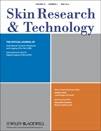Cutaneous resonance running time is decreased in psoriatic lesions
Abstract
Background/aims
Psoriasis is characterized by lower stratum corneum (SC) hydration and dermal inflammation. Both SC hydration and cutaneous inflammation influence cutaneous resonance running time (CRRT). However, the characteristics of CRRT in psoriatic lesions are largely unknown. In the present study, we assessed whether changes in CRRT occur in psoriatic lesions in Chinese.
Methods
A Reviscometer RVM600 and Corneometer CM 825 were used to measure CRRTs and SC hydration, respectively, in psoriatic lesions (psoriasis vulgaris) on the extensor of forearm in 111 subjects (58 men, 53 women), aged 23–80 years (50.42 ± 1.23 years). The contralateral uninvolved sites served as control.
Results
In comparison with contralateral uninvolved sites, CRRTs in psoriatic lesions were reduced significantly in all directions. There was neither gender nor age difference in the extent of reduction in CRRTs. However, the reduction of CRRTs varied with measurement directions. Positive correlations of SC hydration with CRRTs were found at some directions in uninvolved and involved sites in young men whereas CRRTs in psoriatic lesions were not correlated with SC hydration in either aged or young women. Moreover, CRRT at 0–6 o'clock direction was positively correlated with SC hydration in involved sites of aged men.
Conclusion
Cutaneous resonance running times are decreased in psoriatic lesions. Reduction of CRRTs varies with measurement directions, but not gender or age. Measurement of CRRTs could be another valuable approach to assess the severity of psoriasis and the efficacy of its treatment.




